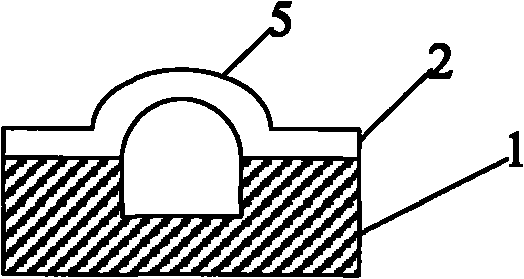Preparation method of photocatalysis microreactor
A technology of microreactor and photocatalysis, which is applied in chemical instruments and methods, physical/chemical process catalysts, chemical/physical processes, etc., can solve problems such as rough surface of microchannels, large fluid flow resistance, and difficult processing, and achieve Good photocatalytic effect, low equipment requirements and simple operation
- Summary
- Abstract
- Description
- Claims
- Application Information
AI Technical Summary
Problems solved by technology
Method used
Image
Examples
Embodiment 1
[0027] A preparation method for a photocatalytic microreactor, comprising the following steps:
[0028] The first step is to etch on the silicon wafer to form a specific silicon microfluidic pattern, and locally place an appropriate amount of high-temperature air release agent on both ends of the silicon microfluidic groove or at a specific position. The high-temperature air release agent is calcium carbonate or titanium hydride powder , the pattern of the silicon microfluidic channel is set according to the graphic needs of the microreactor,
[0029] In the second step, anodically bond the above-mentioned silicon wafer and borosilicate glass wafer in air or vacuum. It can be Pyrex7740 glass or other borosilicate glass, so that the above-mentioned silicon microfluidic channel on the silicon wafer forms a sealed cavity, and is heated in the air to 760 ° C ~ 900 ° C, for example, the temperature can be selected as 800 ° C, 830 ° C , 850°C, 880°C, 890°C, keep warm for 5-10 minut...
Embodiment 2
[0039] A preparation method for a photocatalytic microreactor, comprising the following steps:
[0040] In the first step, utilize Si micromachining process to etch microfluidic channel shallow grooves on Si wafers (such as 4-inch wafers), and the silicon wafer used can be a silicon wafer of standard thickness, such as a silicon wafer with a thickness of 500 microns. The depth of the shallow groove is 10-200 microns, such as 15 microns, 30 microns, 40 microns, 60 microns, 95 microns, 132 microns, 150 microns, 180 microns, and the aspect ratio is usually less than 2, such as 1.5, 1 , 0.8, 0.5, 0.2, 0.1, 0.05, 0.02, the micromachining process of the pattern structure on the Si wafer is a wet etching process, or a dry inductively coupled plasma (ICP) etching process, reactive ion etching One, preferably a wet etching process, such as etching with TMAH solution, the pattern can be striped or serpentine, and adjusted as needed.
[0041] The second step is to place an appropriate a...
Embodiment 3
[0049] A preparation method for a photocatalytic microreactor, comprising the following steps:
[0050] The first step is to use Si micromachining technology to etch microchannel shallow grooves on a 4-inch Si wafer. The silicon wafer used can be a silicon wafer with a standard thickness and a thickness of 500 microns. The depth of the shallow grooves is 60 microns. The runner groove is a strip groove with a diameter of 2 mm, and the length of the groove is 3 cm. The micromachining process of the pattern structure on the Si wafer is a wet etching process, and the used etching solution is a TMAH solution with a concentration of 10% and a temperature of 80 degrees Celsius,
[0051] In the second step, chemically pure calcium carbonate powder is placed in a shallow tank with a particle size of 5 microns and a mass of 30 micrograms.
[0052] The 3rd step, above-mentioned Si disc and Pyrex7740 glass disc (a kind of brand of borosilicate glass, the U.S. Corning-corning company prod...
PUM
| Property | Measurement | Unit |
|---|---|---|
| depth | aaaaa | aaaaa |
Abstract
Description
Claims
Application Information
 Login to View More
Login to View More - R&D
- Intellectual Property
- Life Sciences
- Materials
- Tech Scout
- Unparalleled Data Quality
- Higher Quality Content
- 60% Fewer Hallucinations
Browse by: Latest US Patents, China's latest patents, Technical Efficacy Thesaurus, Application Domain, Technology Topic, Popular Technical Reports.
© 2025 PatSnap. All rights reserved.Legal|Privacy policy|Modern Slavery Act Transparency Statement|Sitemap|About US| Contact US: help@patsnap.com



